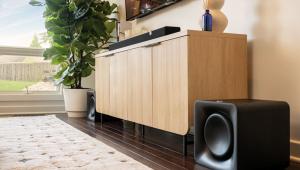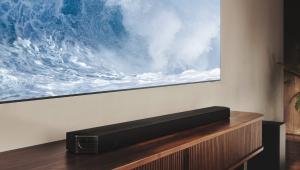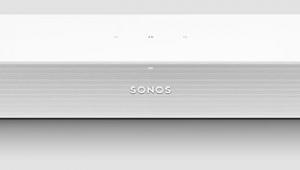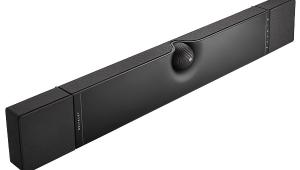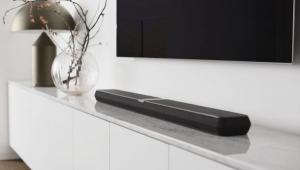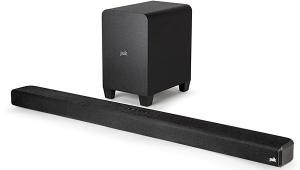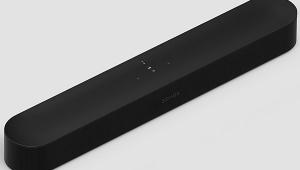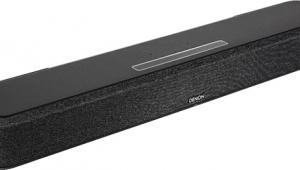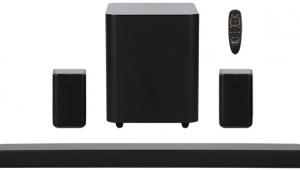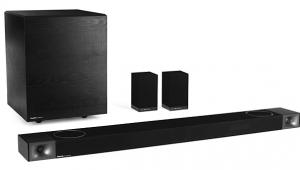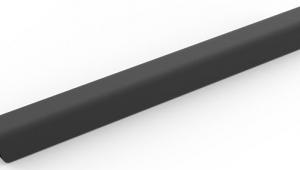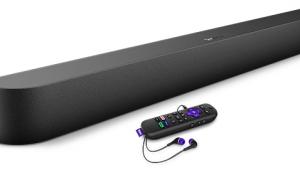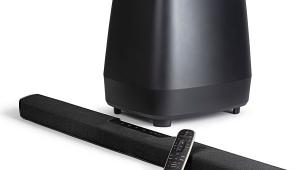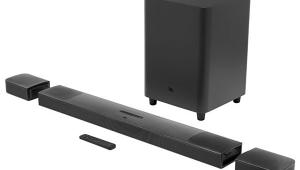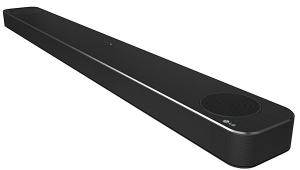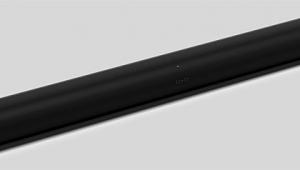This seems like a great device...but is not very useful with only one audio input. I have a cable box, blu-ray and Firebox hooked up...all would need audio inputs to make this work.
Sonos Playbase Review

AT A GLANCE
Plus
Only 2.28 inches tall
Utilizes Sonos Trueplay acoustic tuning technology
Can be part of a Sonos
multiroom audio system
Minus
No volume level indicator
Optical digital and network audio inputs only
THE VERDICT
For the folks who don’t mount their TV on a wall—that is, for the overwhelming majority of TV owners—the Sonos Playbase is an elegant way of creating an excellent-sounding home theater system that’s nearly invisible, super-easy to set up, and blessedly simple to use.
A surprisingly salient special survey by Sonos says that something like 70 percent of slender-TV owners select to stand their set on a flat surface rather than sticking it on a wall. (Say that silently seven times.) Seriously—OK, that’s enough of that—Sonos says that the vast majority of people who own a flat-screen TV don’t mount it on a wall. Instead, they set it on a cabinet, cart, table, shelf, the floor, or just about any other semi-sturdy, close-to-flat surface that isn’t already covered with useless sh-tuff.
All of which causes a problem when it comes to a home theater speaker system, especially if that system is a soundbar. Most soundbars, after all, are designed with wall-mounting as a primary option. When a soundbar is designed with its own stand, it often doesn’t fit under the TV screen because the TV’s foot/leg stands are in the way. Even if it does manage to fit there, it often looks out of place, giving the whole array the appearance of a cluttered mishmash of electronics. And after all, isn’t avoiding such unsightliness one of the biggest reasons for the existence of the soundbar in the first place? (Simplicity is right up there, too.)
An Unhung Hero
Sonos thinks they have the solution to this off-the-wall problem, and it’s called the Playbase. Since Sonos doesn’t roll out a new line of speakers every year or two, it’s exciting when they do introduce a new model. This one is interesting because it’s a soundbase rather than a soundbar—and the soundbase isn’t the most respected of speaker categories, often getting treated (sometimes with good reason) as if it’s the soundbar’s geeky little brother who has no friends. What’s both interesting and exciting for Sound & Vision readers is the fact that Sonos sent us one of the very first Playbase samples to review. In fact, the sample was so “first” that, although the hardware was final, the firmware was still being tweaked. Sonos assured us, however, that any such tweaks wouldn’t affect the quality of sound between our sample and the final production units.
About four years ago, Sonos introduced the company’s first dedicated home theater speaker system, an all-in-one $699 soundbar called the Playbar. It works within a Sonos wireless multiroom streaming audio system, as any other Sonos speaker will, but it does theater sound, too. Like most soundbars, the Playbar can be mounted on the wall under/above a TV, where it looks sleek and sophisticated (and visually less intimidating, in my opinion, than a lot of other bars). Or you can set it on a shelf or cabinet under the screen. Unfortunately, though, when un-hung, the Playbar shares the same hang-ups that other soundbars suffer from when they’re not hung up. Almost immediately after releasing the Playbar, Sonos started looking for a satisfying solution for that group of conscientious wall-mount objectors (those dastardly 70-percenters).

The company set about doing an incredible amount of real-world research into what living, breathing, bona-fide consumers do with a soundbar when they don’t wall-mount their TV. Sonos reps visited people in their homes to see system setups in the wild, and they asked a ton of questions about what people actually want regarding TV sound. Two things stood out: 1) inevitably, when a soundbar is placed on a piece of furniture with a TV, it looks clumsy and out of place; and 2) a soundbar is often crammed into a spot where it sounds like a large fat guy farting underwater in a bathtub. (That’s my description. Sonos used the word awful.)
The company then selected a team to develop a home theater speaker system specifically for off-the-wall situations. There were two key design criteria: 1) it had to be as invisible as possible; and 2) it had to sound great. Ian Popken, the Product Creation Leader for the Playbase, explained to me that the design team made mockup after mockup of potential speaker enclosures in various shapes and sizes and took them to people’s homes to try them out. Much to their collective chagrin, the team quickly discovered that “there’s no such thing as a typical piece of furniture.” Eventually, the best sound/shape compromise they found was a speaker system that also functioned as a base for the TV.
With additional research, it eventually became clear that the optimal height for a TV base that is “as invisible as possible”—but one that, at the same time, doesn’t give the impression that the whole thing is going to collapse at any minute— is 58mm. (That’s engineer-speak for 2.28 inches.) To put this into perspective, your pinky finger is probably longer than that. Although, of course, it’s not the size that matters…unless you’re an acoustic engineer at Sonos. Then you walk away muttering, “58mm? Dude, we’re not miracle workers here, OK?” Well, so much for that “must sound great” criterion, right? (Answering that question is what we’re here for.)
Fusion and Illusion
The dimensions of the Playbase are 28.35 inches wide x 2.28 high x 14.96 deep. The top is Kansas-flat, and the corners are rounded—so it really does blend in and become nearly invisible. Ian told me (with a bit of justifiable pride) that the team basically had to “reinvent every part of the architecture” for the new speaker, including designing custom drivers (in-house, by the way) and developing a custom folded waveguide for the horizontally mounted, 5.25-inch woofer with a special flared port configuration that minimizes turbulence as pressure exits the cabinet. As if that weren’t enough, the Playbase includes a trio of 1-inch tweeters. The outer two tweeters fire at an angle from the rounded corners, while the center one is forward-facing and includes a customized waveguide for controlling dispersion. The six (yes, six) 2-inch midrange drivers use a spiderless design with ferrofluid damping (ferrofluid helps center the voice coil in the magnetic gap, rather than a mechanical spider assembly). This transducer was designed to have especially long excursion capability for its size. Each one of the ten drivers in the cabinet is driven by its own dedicated Class D amplifier.

Even the structural material used in the enclosure had to be engineered from scratch. A metal cabinet, for example, wouldn’t have been good for the Playbase’s built-in wireless connectivity. A 2.28-inch-tall plastic cabinet wouldn’t have been strong enough to bear the weight of some TVs. Rather than chiseling the enclosure out of granite (and incurring outrageous shipping costs), Sonos’ engineering team came up with an “acoustically inert,” extremely strong, rigid material consisting of polycarbonate infused with glass. The stuff is so stiff and sturdy that the Playbase can support a TV as heavy as 77 pounds. Another advantage of the glass-infused polycarbonate material is that all the parts can be fused together at the final manufacturing step—creating a gorgeous cabinet with absolutely no visible seams. It almost looks like it was chiseled out of granite To top it off, the material allows for either black or white styling to match Sonos’ existing color schemes for other products and better fit a wider range of decors.
In keeping with the seamless look, there is no externally mounted grille. Instead, 43,000 tiny holes (that’s an approximate number—but what’s a few holes among friends?) are drilled (yes, drilled) through the polycarbonate wrapping the front and side faces of the cabinet. The holes are intentionally made small so that you can’t see the drivers behind them from typical viewing distances. But if you get extremely close, and have excellent eyesight, you might just notice that there are actually five sizes of holes, which get progressively larger as they get farther from the center face of the cabinet. Ian said it was configured that way in order to let more air pressure from the drivers pass into the room. (Nope, not going to do the obvious joke.)
So, What’s a 5.1-Channel Signal Doing in a Base Like This?
One of the best aspects of a Sonos speaker system has always been its simplicity, and the company resisted the opportunity to gussy up the Playbase with multiple soundprocessing choices and lots of video switching. In fact, the speaker doesn’t do any video or audio source switching. It doesn’t even have an HDMI port. The only inputs are an optical digital audio jack and an Ethernet jack. Throw in the AC power cord, and that’s the extent of its wired connectivity.
Wireless connectivity is just as simple. The Playbase is Wi-Fi only, with no built-in Bluetooth connectivity. Bluetooth isn’t needed because, like all other Sonos speakers, this one is a standalone system that connects to your home network via Wi-Fi (or Ethernet) and runs on Sonos’ proprietary OS. That means it has access to all the same network-attached or mobile device-based media stored on your network or phone, as well virtually any streaming music service you can name (thanks to Sonos’ unparalleled platform of integrated partners).
The Playbase can be easily integrated into an existing or new Sonos multiroom streaming audio system by simply identifying it in the Sonos app. It’s just as easy to add a Sonos Sub and a pair of speakers from the company’s Play series, for rear channels to enable discrete 5.1-channel surround playback.
Some folks may not like the minimalism of the Playbase and the fact that it relies on the TV to do all of the A/V source switching. But the intent of the design is to keep things as simple as possible. To that end, the Playbase automatically turns on whenever an audio signal is sent from the TV to the speaker. (Automatic is good.) It can learn the commands for volume up/down from your TV’s infrared remote control. Alternatively, you can use the touch-sensitive “buttons” on the top of the Playbase to control the volume, or you can use the Sonos app. As a result, you could install the speaker under your greatgrandmother’s TV (or the TV your three-year-old watches), and the only difference would be that the setup will sound a hell of a lot better. From the standpoint of the person holding the remote control, nothing operationally would need to change. For many, many people, that’s not a big deal; that’s a huge deal.
- Log in or register to post comments



I agree with you ...but I think they have limited (probably purposefully) their potential customer base. ...I have optical outs on my various devices, but not on the tv

The scoring for all the Sonos soundbars on here are inflated -- they should receive 3 stars for Features, not 4.5 stars. How can they get 4.5 stars when they do not support DTS of any kind, Atmos, HDMI inputs, HD/hires audio, and other features I can't think of right now?

